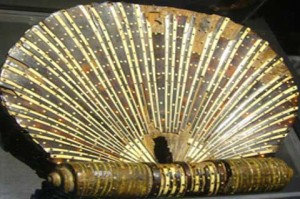ENIGMA OF THE ‘ATRIL VATICANO’ IN CUBA
The earliest example of Aboriginal Christian art of the New World, believed to have been created by native Cubans is exhibiting since this past Sunday at the Palace of the Captains General, Havana thanks to the kindness of the Missionary Ethnological Museum of the Vatican.
The earliest example of indigenous Christian art of the New World, a missal holder of the late fifteenth century, was brought to Havana by the Missionary Ethnological Museum Vatican and will be exhibited at the Museum of the City or Palace of the Captains General for one year from Sunday.
The piece consists of a shell-shaped stand to hold the missal (Mass book), made of carved wood with thin strips of fish bones and tortoise shell, inlaid on its surface in a fan shape, which are alternative and create a chiaroscuro effect. At the base which supports the prayer book is a wide opening possibly used to attach it to a pedestal.
It is believed that belonged to Fray Bartolome de las Heras, chaplain of Christopher Columbus in his first trips to America, who remained in Cuba to evangelize the tribes Caribbean. The podium or lectern, made of carved wood, shell-shaped bone inlaid with tortoise shell fish and presumably belonged to a chaplain named Bartolome de Las Heras who accompanied Christopher Columbus on his second voyage to America (1493-1494 .)
Archaeological evidence shows that was developed by Cuban Taino Indians, probably based in Santiago de Cuba before 1510. For Indians the shell had a high symbolic value, since it is linked to the cult to water and fertility, while for Christians is associated with the resurrection and eternal life.
Missal holder will be displayed from this week and for one year at the City Museum in Havana, with a loan authorized by Cardinal Tarcisio Bertone, Vatican secretary of state.
Ernest’s father Baudouy, order the Augustinians of the Assumption, in 1935 the lectern donor to the Vatican Ethnological Museum, the piece received from his mother, born in Santiago de Cuba, who inherited it from generation to generation and cree that belonged to a descendant of Bartolome de las Heras.
According to research by Eusebio Leal Spengler, Historian of the City, “we are facing the enigma of the Vatican stand.” Leal explained that the name of the said Fray was not on the records of the monks who accompanied Columbus on his expeditions to the New World called, so no way to say that the original owner of the missal was actually carrying the chaplain of the discoverer of America.
According to Leal, one can say that the object came from Cuba, has a “very remarkable old” and uses elements that are “very own” Cuban environment such as wood, bone and tortoiseshell.
In this regard, said the Vatican has called on Cuba “strongly” to proceed with laboratory studies, archeology, ethnology, history and art history for the results will be published.
At the start of the exhibition of the piece was attended by Cardinal Jaime Ortega, Archbishop of Havana, Monsignor Bruno Musaró and Father Nicola Mapelli, director of the Missionary Ethnological Museum of the Vatican. Also present Homero Acosta, secretary of the State Council and Dagoberto Ramirez, Deputy Foreign Minister, among others.
Sources: SiempreMex / AtrilVaticanoCuba / InternetPhotos / TheCubanHistory.com
The ‘Stand Vatican’ in Cuba / The Cuban History / Arnoldo Varona, Publisher
EL ENIGMA DEL ‘ATRIL VATICANO’ EN CUBA
El más antiguo ejemplo de arte cristiano aborigen del llamado Nuevo Mundo, que se cree fue creado por nativos cubanos se esta exhibiendo desde el pasado domingo en el Palacio de los Capitanes Generales gracias a la gentileza del Museo Etnológico Misionero del Vaticano.
El más antiguo ejemplo de arte cristiano indígena del llamado Nuevo Mundo, un porta misal de finales del siglo XV, fue traído a La Habana por el Museo Etnológico Misionero del Vaticano y será exhibido en el Museo de la Ciudad o Palacio de los Capitanes Generales durante un año a partir del domingo.
La pieza consiste en un atril en forma de concha para sostener el misal (libro de misas), hecha en madera tallada con finas tiras de huesos de pescados y de carapacho de carey, incrustadas sobre su superficie en forma de abanico, los cuales están alternos y crean un efecto de claroscuro. En la base donde se apoya el libro de misa se observa una amplia abertura posiblemente utilizada para fijarla a un pedestal.
Se cree que perteneció a fray Bartolomé de las Heras, capellán de Cristóbal Colón en sus primeros viajes a América, quien permaneció en Cuba para evangelizar las tribus caribeñas. El atril o facistol, elaborado en madera tallada en forma de concha con incrustaciones de hueso de pescado y caparazón de carey, presumiblemente perteneció a un capellán llamado fray Bartolomé de Las Heras que acompañó a Cristóbal Colón en su segundo viaje a América (1493-1494).
Las evidencias arqueológicas demuestran que fue elaborado por aborígenes taínos cubanos, probablemente radicados en Santiago de Cuba antes de 1510. Para los indígenas la concha tenía un elevado valor simbólico, por cuanto está vinculada a los cultos al agua y a la fertilidad, mientras que para los cristianos se asocia a la resurrección y a la vida eterna.
El porta misal se exhibirá desde esta semana y por un año en el Museo de la Ciudad en La Habana, gracias a un préstamo autorizado por el cardenal Tarcisio Bertone, secretario de Estado del Vaticano.
El padre Ernest Baudouy, de la orden los Agustinianos de la Asunción, donador en 1935 del facistol al Museo Etnológico del Vaticano, recibió la pieza de manos de su madre, nacida en Santiago de Cuba, quien la heredó de generación en generación y se cree que perteneció a una descendiente de Bartolomé de las Heras.
Según investigaciones de Eusebio Leal Spengler, Historiador de la Ciudad, «nos encontramos ante el enigma del atril vaticano». Leal explicó que el nombre del mencionado Fray no figura en los registros de los monjes que acompañaron a Colón en sus expediciones al llamado Nuevo Mundo, por lo cual no hay manera de afirmar que el dueño original del porta misal fuera realmente el capellán del descubridor de América.
De acuerdo con Leal, se puede afirmar que el objeto salió de Cuba, tiene una “antigüedad notabilísima” y usa elementos que son “muy propios” del entorno cubano como la madera, el hueso y el carey.
En ese sentido, dijo que el Vaticano ha solicitado a Cuba “encarecidamente” que proceda con los estudios de laboratorio, arqueología, etnología, historia e historia del Arte correspondientes, cuyos resultados serán publicados.
Al inicio de la exhibición de la pieza asistieron el Cardenal Jaime Ortega Alamino, Arzobispo de La Habana; Monseñor Bruno Musaró y el padre Nicola Mapelli, director del Museo Etnológico Misionero del Vaticano. También se encontraban presentes Homero Acosta, secretario del Consejo de Estado y Dagoberto Ramírez, viceministro de Relaciones Exteriores, entre otras personalidades.
Sources: SiempreMex/AtrilVaticanoCuba/InternetPhotos/TheCubanHistory.com
El ‘Atril Vaticano’ en Cuba/The Cuban History/ Arnoldo Varona, Editor






